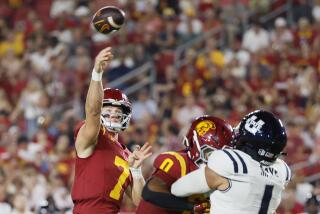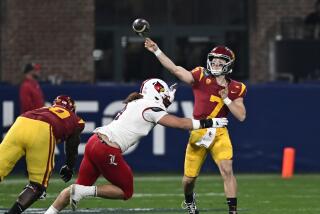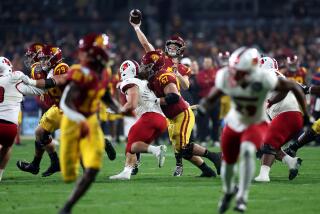Tulsa Runs San Diego State Aground : Aztecs: Behind Jackson’s 211 rushing yards, Tulsa wins 28-17 to spoil SDSU’s first postseason appearance since 1986.
ANAHEIM — For those who may have missed the Freedom Bowl on Monday night, here is a quick, fairly complete recap:
Marshall Faulk. Ron Jackson. Faulk. Jackson. Faulk. Jackson. Faulk. Jackson.
It was like counting sheep when you’re trying to fall asleep. One, two, three, zzzzzz.
Tulsa defeated San Diego State, 28-17, in front of 34,217 in Anaheim Stadium in a game that came down to mistakes rather than big plays.
“We didn’t do the things it takes to win,” SDSU Coach Al Luginbill said. “I told our football team I did a horrible job with them.”
Both teams came out with a game plan as conservative as George Bush. You can find more imagination on campus at a meeting of business majors.
Jackson, Tulsa’s replacement for suspended running back Chris Hughley, rushed a Freedom Bowl-record 46 times for 211 yards and four touchdowns. He also caught a pass for 14 yards.
Faulk countered with 30 for 157 yards and one touchdown. Faulk also had nine pass receptions for 42 yards.
Of 150 total offensive games in the play, Jackson and Faulk combined to touch the ball on 86 of them. Each player was selected his team’s most valuable player.
The other players basically served as the straight men, and whomever got away without making a mistake was lucky.
SDSU attempted an onside kick in the first quarter, but it only traveled six yards and set Tulsa up for its first touchdown.
SDSU lost a fumble at the one; Tulsa returned the favor later at the two.
But the most glaring mistake came with Tulsa ahead, 21-17, the clock ticking down to 4 1/2 minutes left in the game, and SDSU set to receive a punt.
Tulsa’s Gus Frerotte got one off that went 54 yards, sailing over T.C. Wright’s head. Wright drifted back, stuck up his right hand, the ball came down . . . and bounced off his hand. Tulsa recovered at the four, and Jackson scored the clinching touchdown.
“Obviously, we wanted to get the return and field position,” Luginbill said. “Their guy uncharacteristically boomed a punt. It wasn’t so much the muff on our part, but we didn’t recover the ball.”
Then, trailing by 11 and faced with a fourth down from their own 24 with 3:59 to play, the Aztecs inexplicably chose to punt.
“It was a decision I made,” Luginbill said. “I felt that a turnover or a take-away or something positive could happen, rather than if we didn’t make it giving them field position.
“Obviously, I was wrong.”
The Aztecs (8-4-1), making their first postseason appearance since the 1986 Holiday Bowl, spent a lot of time afterward taking the blame. Quarterback David Lowery, who completed 19 of 37 passes for 164 yards, completed only two of his final 14 attempts.
He was only two of nine in the second half for minus -five yards.
“I didn’t throw the ball where it should be, I guess,” Lowery said. “They batted a couple of balls down and knocked a couple of balls out of receivers’ hands.”
Said Faulk: “We started with our running game and had to go to the pass. Since we were using our running game so much and didn’t pass, our passing game was cold.”
SDSU managed only an Andy Trakas field goal, from 26 yards, in the second half.
Aside from Jackson’s four-yard touchdown run after Wright’s fumble, Tulsa’s only touchdown came on a 10-play, 40-yard drive in the third quarter.
After scoring a touchdown on its second possession, SDSU went for a quick knockout punch with an onside kick. It failed, and led to Tulsa’s first touchdown.
Which figured because, in this one, going for the quick fix was like trying to milk a dog. It wasn’t going to happen.
This developed early into a slugfest featuring each team’s offensive line. Long, drawn out, bruising drives. Lowery set a Freedom Bowl record by completing each of his first nine passes, but most were quick outs thrown underneath the Tulsa coverage. Five of the nine were sideline flares to Faulk, most in the five- to seven-yard range.
By halftime, Lowery had completed 17 of 26 passes for 169 yards.
SDSU’s first touchdown drive covered 86 yards and took 15 plays. Faulk went in from the two with 5:23 left in the first quarter.
No surprise there. At one point, Faulk had a hand in 20 of SDSU’s first 31 plays.
Two first-half plays SDSU fans will remember, though, didn’t involve Faulk.
The first: After taking the 7-0 lead, Trakas’ onside kick attempt only traveled six yards, and Tulsa had its best field position of the evening.
The Golden Hurricane used six plays to move 46 yards--five of them Jackson runs. He scored on a 10-yarder to tie the game.
The second: After Jackson’s touchdown, SDSU moved 53 yards, all the way to the Tulsa nine, before Wayne Pittman fumbled at the one. Junior defensive back Dennis Hickey landed on it in the end zone, and Tulsa escaped.
The teams then traded touchdowns in the second quarter. T.J. Rubley, who completed nine of 17 passes for the game for 122 yards, completed a 27-yard pass to Chris Penn--the longest play of the half by either team. That help set up Tulsa’s touchdown, a six-yard run around right end by Jackson.
SDSU tied things at 14, though, on its next possession by moving 65 yards in 10 plays. Lowery scored the touchdown on a four-yard quarterback sneak, following linemen Jim Jennings and Joe Heinz into the end zone.
Which was only fitting. Those quick-strike, hold-your-breath SDSU plays against Brigham Young were a distant memory.
More to Read
Go beyond the scoreboard
Get the latest on L.A.'s teams in the daily Sports Report newsletter.
You may occasionally receive promotional content from the Los Angeles Times.










